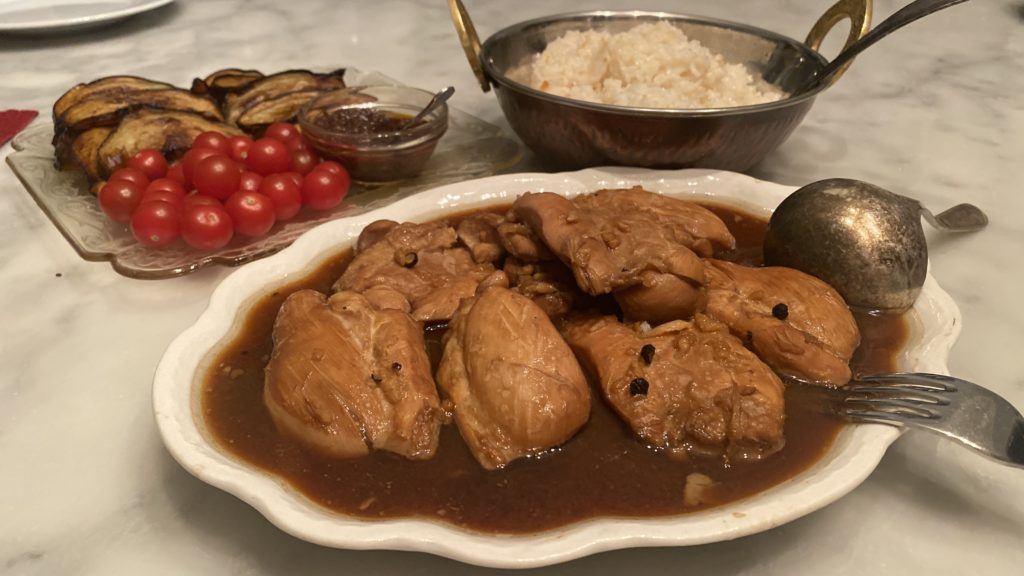This is a guest post from Jen in the Philippines, who traded in her job as a corporate manager to pursue her passion for food and cooking. After realizing “that there’s more to life than being in an office day in and day out,” she quit her job and is now the proud owner of two small businesses for which she bakes delectable, home-baked goodies such as cheesecakes, cookies, and all-natural dog treats. Jen has also recently started blogging about her home cooking and favorite foods on Instagram.
story
History 101
When I was asked to write a guest post for Cultures Capsules, I spent a couple of days thinking about which Filipino dish to feature. There were a lot on my list, but I finally decided to write about a dish that a lot of Filipinos are proud to call our national dish and personal favorite: Adobo.
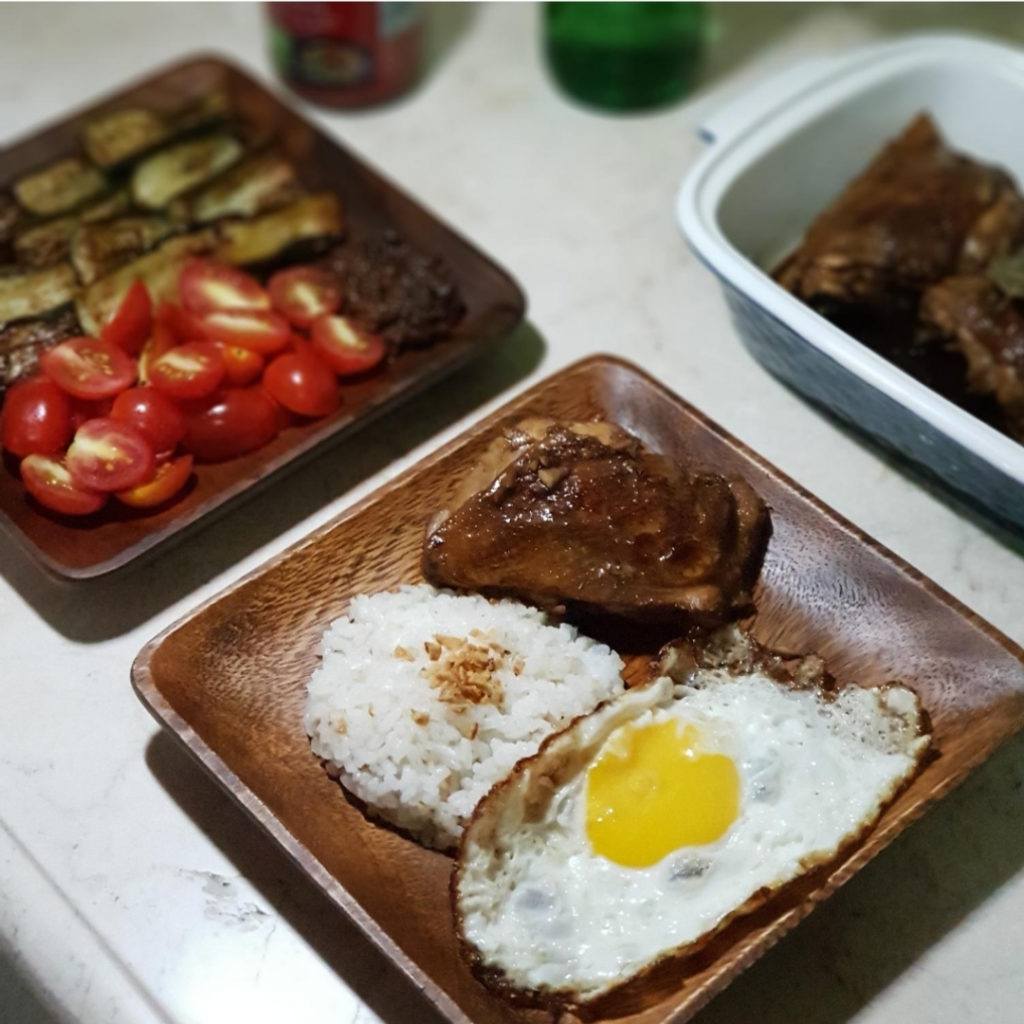
Not to be confused with its Spanish namesake (which, consequently, was the result of 300 years of colonization), Filipino Adobo has existed way before Ferdinand Magellan laid foot on Philippine shores. This recipe was born out of necessity – my country’s humid and warm climate meant that meats could spoil easily, and since refrigerators hadn’t been invented, Filipino natives had to look for ways to preserve food. They found that the acidity of the vinegar and the high salt content of soy sauce prevents bacterial growth and therefore, stopped meats from spoiling easily. Because of its delicious flavor, Adobo has become a popular dish amongst Filipinos.
Nowadays, we cook almost anything Adobo style (meats or vegetables are marinated in vinegar and soy sauce then slow-braised) including pork, chicken, beef, squid, mussels, hardboiled egg, the infamous balut, sitaw (yardlong bean), kangkong (water spinach), and even offal – the most popular are pork or chicken liver and chicken gizzard.
There are as many variations of Adobo as there are Filipino mothers, but these basic ingredients are always present: vinegar and soy sauce. There’s a related version called Adobo Sa Puti, which translates to White Adobo and it doesn’t call for soy sauce but that’s a story for another day. Of course, what I’ll be sharing with you later on in this post is derived from my mom’s recipe – with some minor tweaks to make it my own.
story
My Food Memories
As a child, I was often present in the kitchen whenever mom was cooking, observing how she whipped up the most delicious meals. I wouldn’t have guessed it but surprisingly, when mom got married, she didn’t have a clue how to cook and it was dad who taught her. I cook the way my parents cook (and probably how most Asians cook) – adding a dash of this and a pinch of that – never really following a recipe to a T, but letting our intuition and senses guide us.

Our daily meals consist mainly of rice and ulam (main dish), which usually includes meat, fish, or vegetables, or a combination of these. Of course, when there’s a special occasion, we cook at least three different ulam and we also serve desserts such as Leche Flan, Buko Pandan, and Pinoy Fruit Salad.
Growing up, I learned how to cook these traditional Pinoy foods from my mom. We don’t keep a recipe book and I’ve never written one down. Years and years of watching my mom cook as well as regularly watching cooking shows have imbued my memory with a ton of recipes. Now that I’m older, I’m able to tweak those recipes so I can call them my own.
story
Filipino Culture in a Nutshell
Before we get to the recipes, I want you to get to know the Filipino Culture more. Here’s a snapshot of our culture and I hope it helps give you a better experience and deeper appreciation of the simple Filipino feast that you’re about to enjoy later.

- Filipinos greet each other with the expression “Kumain ka na ba?” (have you eaten?) – an ode to our love of food and sharing it with family and friends.
- We love to party. No matter where you are in the Philippines, you are bound to find a local fiesta or festival. Every municipality has a patron saint whose day is celebrated extravagantly with a bountiful feast and you can go from house to house to sample everyone’s dishes.
- We have the longest Christmas celebration. As early as August, you’ll start to hear Christmas carols playing on the radio and festive decorations being put up everywhere. We don’t take down the decorations until the second week of January.
- Filipinos love to sing. No one cares if you can’t carry a tune – we all belt out our favorite songs on the videoke (karaoke).
music
OPM (Original Pinoy Music)
I created this playlist as I was writing this post. I wanted anyone who listens to it to feel the way I feel about Adobo, cooking, and Filipino culture – happy, feel-good, cheery, passionate, and proud. Listen closely to Black Eyed Peas’ “Bebot” and you’ll hear Apl De Ap (who’s half-Filipino, by the way) mention Chicken Adobo as well as traditional indigenous Filipino musical instruments in the beats.
The below is a one minute video time lapse of Megs making my favorite Filipino Adobo feast. In it, you can see (and hear) my playlist helping along the food as it cooked one August evening in 2020… in New York City!
recipe
Overall Plan
The recipes that I’m about to share aren’t typically eaten together but this is how I enjoy eating Adobo – paired with eggs, a side of veggies, and of course, rice. It’s perfect for breakfast and lunch but you can also have it for dinner – there are no rules here!

To achieve the perfect Sinangag (garlic fried rice), you need to cook your rice a day in advance and put it in the fridge (once it’s completely cooled) to dry. On the day, you can fry the eggs, eggplant, and then cook the Sinangag while the Chicken Adobo is simmering.
Don’t forget to blast the playlist on your speakers while cooking. Be warned, though: some of the tunes will make you want to dance!
recipe
Chicken Adobo
This is my version of Chicken Adobo, derived from my mom’s recipe. She’d use all the parts from a whole chicken, gizzards, and livers but if I’m cooking, I prefer to use chicken thighs simply because it’s my favorite part. You can double the recipe, so you’ll have some leftover because Adobo actually tastes better a few days later.
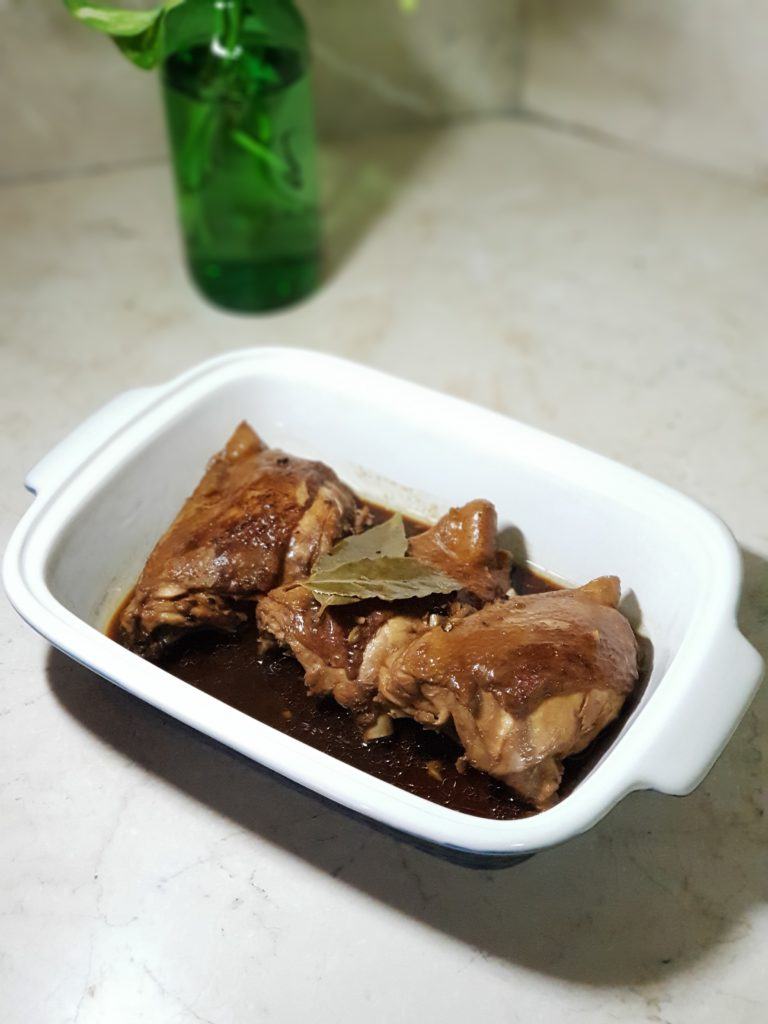
Chicken Adobo
Ingredients
- 2 pounds chicken thighs whole
- 5 cloves garlic minced
- 1/3 cup soy sauce do not use dark or low sodium soy sauce
- ¼ cup cane vinegar or use regular white vinegar if you can’t find it
- 1 tbsp brown sugar
- 1 tsp peppercorns cracked
- 2 dried bay leaves
- 2 tbsp canola oil or any neutral oil
- 1 cup water
Instructions
- In a large bowl, combine all the ingredients except the oil and water.
- Cover and marinate in the fridge for 20 minutes. Do not throw away the marinade.
- Heat the oil in a pot.
- Pat the chicken dry and sear both sides on high heat.
- Pour in the marinade and water. Cover the pot.
- Once the sauce is boiling, turn the heat on low to barely a simmer and let the chicken cook for about 30 minutes, turning it once, halfway through.
- Remove the cover to let the sauce thicken and evaporate a bit and simmer for another 10 minutes or until the chicken is tender.
- Serve warm with steamed rice or Sinangag.
Notes
recipe
Crispy Fried Eggs
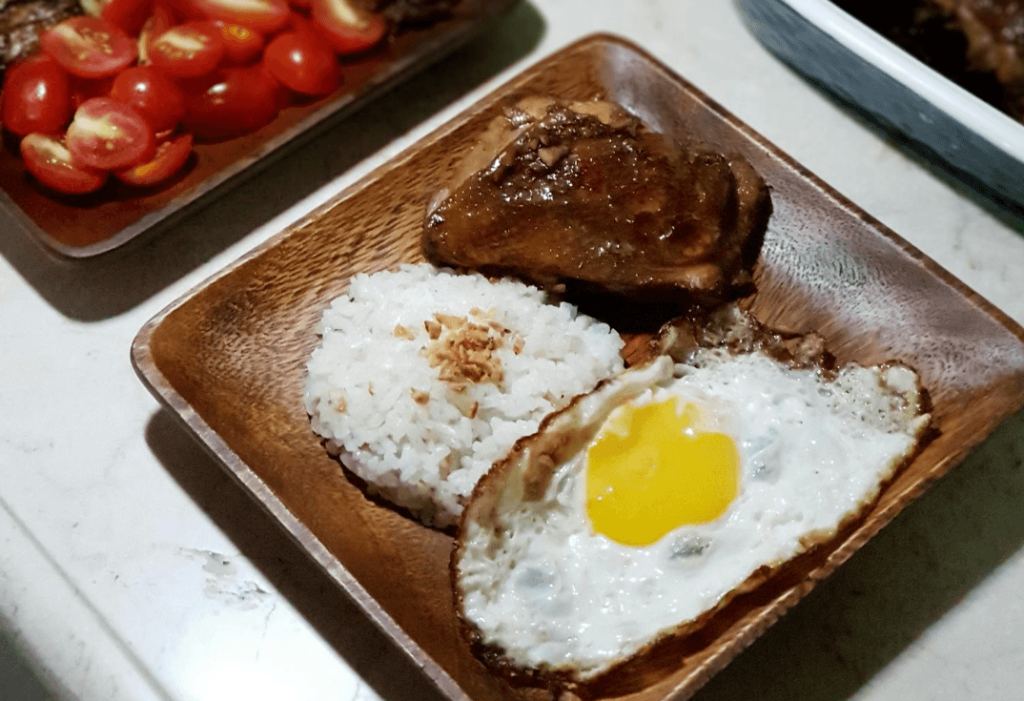
Adobo isn’t usually served with fried eggs (hardboiled eggs are the norm) but the combination of the runny yolk, crispy white, and garlicky rice with the salty, sweet, and tangy chicken is just heaven for me.
Crispy Fried Eggs
Equipment
- Non-stick frying pan
Ingredients
- canola oil enough to cover the bottom of your pan
- eggs
- salt to taste
Instructions
- Heat the oil in the frying pan.
- Crack the eggs one by one in a small bowl before carefully pouring into the frying pan to make sure you don’t get shells in your eggs.
- Sprinkle a pinch of salt over each egg.
- Fry on high heat for about 3 to 5 minutes or until the edges are brown and crispy but the yolk is still runny.
Notes
recipe
Pritong Talong at Bagoong
Filipinos love fermented or pickled food. One of the most popular and widely used is bagoong alamang or fermented shrimp paste, and I love it in Pritong Talong at Bagoong (Fried Eggplant and Fermented Shrimp Paste).
My personal favorite is the spicy variety by the Barrio Fiesta brand. Bagoong is salty and it goes well with fruits and vegetables such as green mangoes, eggplant, okra, water spinach, tomatoes, and we even use it for fried rice. It’s an acquired taste but don’t be afraid to try it!
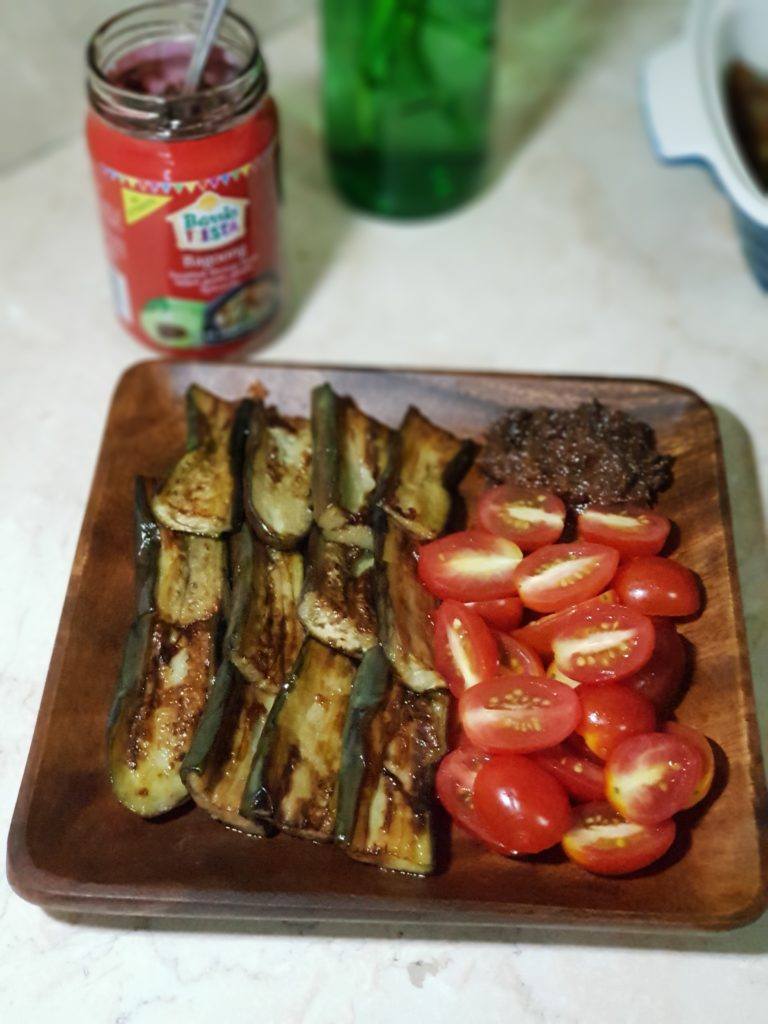
Pritong Talong at Bagoong (Fried Eggplant and Fermented Shrimp Paste)
Equipment
- Non-stick frying pan
Ingredients
- 2 eggplants sliced lengthwise about 2 inches long and ¼ inch thick
- canola oil enough to cover bottom of frying pan
- 4 tomatoes sliced (or about dozen cherry tomatoes)
- 1 tbsp spicy fermented shrimp paste or more, as desired
Instructions
- Heat oil in a frying pan.
- Fry the eggplant on medium heat for about 2 minutes or until browned on each side. You might need to refill the oil for every batch as the eggplant slices will absorb the oil.
- Place on paper towels to get rid of excess oil.
- Slice the tomatoes thinly (or if using cherry tomatoes, cut it in half) and assemble on a plate with the fried eggplant.
- Serve with spicy fermented shrimp paste.
recipe
Sinangag
We eat rice with every meal and we usually start our day with Sinangag (Garlic Fried Rice). Filipinos do not want any food to go to waste and Sinangag makes good use of leftover rice from the day before. At home, mom would deliberately cook a little more than enough rice so we’re always sure to have some leftover for the next day’s Sinangag.
Sinangag (Garlic Fried Rice)
Equipment
- Large skillet or wok
Ingredients
- 2 tbsp canola oil
- 1/2 tbsp garlic minced
- 4 cups day-old cooked rice
- salt to taste
Instructions
- Heat oil in a large skillet or wok.
- Add the garlic and sauté on medium heat just until it’s brown but not burnt.
- Add rice, then salt, and stir-fry for about 5 minutes or until rice is evenly heated and smells of garlic.
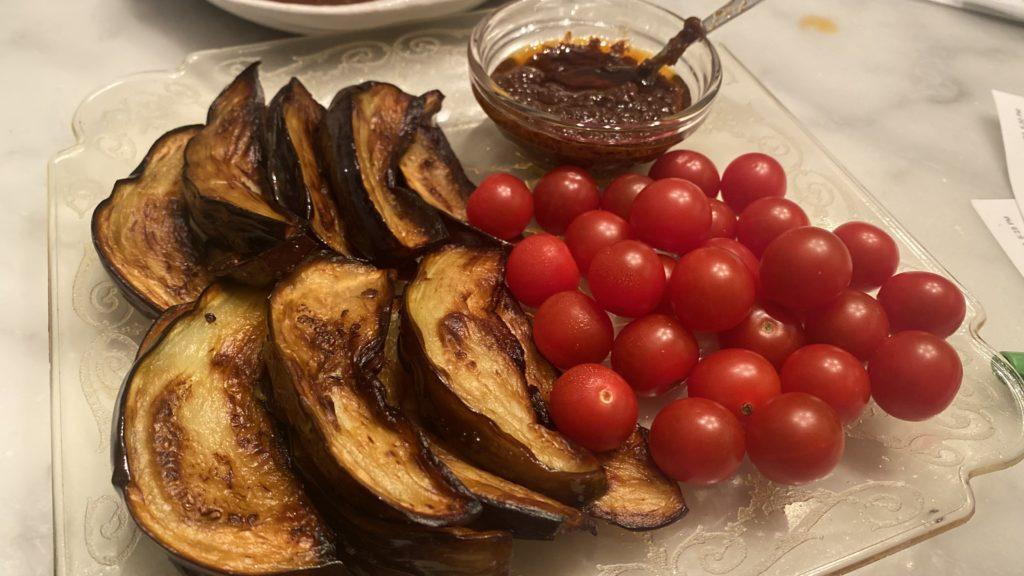
Bonus
How to Cook Rice the Filipino Way
As I mentioned earlier, rice is a staple in every Filipino meal. Learning how to cook rice is somewhat a rite of passage for every Filipino teenager and we all learn one special method from our parents. I leave you with this hilarious video to find out what that method is.
(Note: please watch with discretion, as the video contains explicit language).
Your Turn!
Try it yourself, and let us know how it goes! The below is from Megs’ replay of this home-cooked Filipino Feast in Brooklyn, NY one warm evening in August 2020. Don’t forget to tag us so we can see! #culturescapsules
